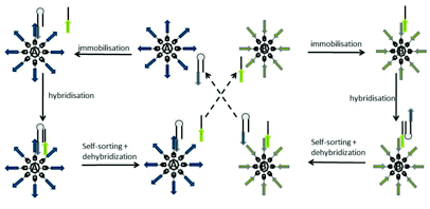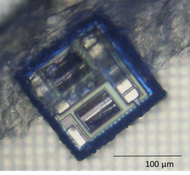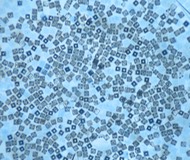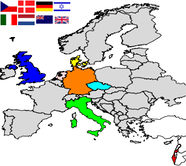The cloning and amplification of lablets is an advancement of the iterative, stepwise SPREAD method [1] by the extension to an autonomous process and the development of orthogonal immobilization strategies for different surfaces.

Figure 1: From SPREAD to autonomous SPREAD
The identity and functionality of a lablet is defined by surface and the DNA sequence, immobilizing on this surface. To implement Cloning and Amplification by information transfer from lablet to lablet we develop an autonomous SPREAD procedure, where complementary DNA sequences replicate on orthogonal surfaces of the lablets (Figure 1). The DNA transfer between the surfaces will be autonomous. This can be achieved by electrotransfer and/or by a pH-driven hybridization/de-hybridization step.
To develop an autonomous SPREAD system compatible with various lablet surfaces we follow the strategy of an amplificatory self-sorting on paramagnetic beads as a model system. The system is based on two or more bead types which immobilize specific DNA sequences. The latter are able to sort out their complementary sequences from a DNA-pool. If the sequences sorted out can also immobilize on specific beads, subsequent repetition of hybridization, washing and dehybridization steps would lead to an enrichment of sequences with each cycle (Figure2).

Figure 2: Scheme for amplificatory self-sorting on orthogonally DNA-labeled surfaces
Since a multitude of orthogonal and DNA-specific beads or surfaces is not readily accessible we decided to address the immobilization by DNA hybridization itself. In this case we only need one suitable DNA anchoring technique for one type of surface. The surface anchored DNA would therewith define different lablets or differing permeation layers on lablets and the first hybridization event would equal the orthogonal immobilization.
As a model surface for the amplificatory self-sorting, paramagnetic beads with a diameter of 1µm with amino-modification or a streptavidin-coating were tested for DNA immobilization. Biotinylated DNA binds to the streptavidin beads and the amino-beads can be addressed by a bisaldehyde-modifier, generated in situ by oxidation of a uridine-nucleotide in the DNA sequence. Immobilization tests were performed for both types of beads.
References
[1] Luther, A., Brandsch, R., von Kiedrowski, G. Nature 396, 245-248 (1998).




